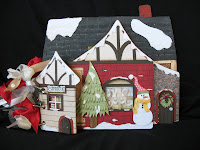Several months ago I came across this old desk chair in a second hand store. One of the casters was missing, and the faux leather was ripped.
...and it was very dirty, and ugly
...but had great structure, and bones.
So I went to work.. I'll walk you through the steps. Refinishing and upholstery work really isn't difficult, it just requires a lot of time and patience.
To start, remove all the "jewelry." Castor feet, hardware, upholstery tacks etc.
Then strip the old upholstery fabric and foam or batting. If your project is full upholster, and no wood refinishing, there isn't always a need to remove all the foam, unless it needs to be replaced.
Next, because my chair had such a dark finish, and I was moving to a white painted finish, I started with about 6 coats of spray paint as a base. After the base had dried completely overnight, apply 4-5 additional coats of paint by brush, working in VERY thin layers, and sanding between coats as necessary.
I wanted a worn look so I used a power finishing sander to remove layers of paint down to the wood. I then applied a gel stain to the exposed wood only, wiping clean immediately after application. Finish by lightly sanding with 300-600 grit sandpaper. Wipe clean and apply a coat of finishing wax to seal.
Next I attached the caster feet. Normally I would wait until the project is complete before applying hardware, but having the caster feet attached made the chair easier to work with in this case.
Next... Upholstery.
This chair is unique in that it has no structured back, but relies on the tension of the fabric to support the back. It's important to note that you will be working from the back of the chair towards the front, with quite a few layers of fabric. Start by stretching tight and stapling in place the backing. The right side of the fabric should be facing outward so the right side is visible when looking at the back of the chair.
Staples should be less placed about 1/2 - 3/4 inch apart or less.
Because I was using lightweight fabric, and I was concerned about it ripping out, I added a layer of heavy canvas after the back layer. Staple in place exactly as the bottom layer.
Trim excess fabric from the edges after each layer.
After the canvas is a layer of felt material.
Again, for the best finish, the staples must be close together. Hammer down any staples that don't go all the way in.
Next the foam cushion is glued in place to the felt material, a layer of quilt batting is placed over the foam, and the top layer of fabric is stapled in place.
Trim the edge of the fabric.
Piping.
I prefer to make my own, which allows me absolute freedom when it comes to fabrics. Because I was working with a rather thin channel I opted to trim the unfinished edge of the chair back with piping and apply in place with hot glue.
I prefer to make my own, which allows me absolute freedom when it comes to fabrics. Because I was working with a rather thin channel I opted to trim the unfinished edge of the chair back with piping and apply in place with hot glue.
That was a first for me... using hot glue when finishing upholstery...
This chair originally had upholstery tacks all around the edges on the backing and seat cushion. Since this chair is for my art studio, I opted from something a little more CAM chic... Vintage buttons.... hot glued in place.
When I bought these buttons a lot of them had been cut right off of clothing, so they still had the thread attached.
Vintage button rivets.
I love you.
I love you.
On the back of the chair back I glued more piping in place. trimming the unfinished edge of the piping very short, and gluing the unfinished piping edge into the inside corner.
To finish the armrests, start by gluing or stapling piping around the edge, then glue or staple batting in place as shown.
Apply the top layer of fabric by carefully applying hot glue to the inside edge of the piping and then stretching the fabric; folding the unfinished edge under and applying to the glue.
To finish the seat, use a seam ripper to take the old seat cover apart. Use each piece of the older cover as a pattern to cut the new cover. Sew the new cover together.
And seriously.. could this even be considered a Cam chair if there was no turquoise?
Apply a layer of batting to the foam seat base, and then fit the fabric, stretching and stapling in place.
Work from opposite sides.... in other words: pull the fabric tight in the front, and apply one or two staples. Then pull the fabric tight in the back and apply one to two staples... and so on.
For the best finish, the more staples the better.
Trim excess fabric and batting.
Because my chair seat sits directly on the finished wood seat, I hot glued a layer of flannel over the bottom of the seat cushion to cover the wood and staples.
Fit the seat cushion in place and... finished!
Lube the bearings and wheels if necessary.
::I love you chair::
Beautiful Cam Chair.
The Cam Chair.
It's not for sale... and if you steal it I will hunt you down.
It's not for sale... and if you steal it I will hunt you down.
xoxo Cam









































5 comments:
LOVE the Cam chair! Can you come to my house now??
Gorgeous chair, just like you!!
It's fantastic Cam! I'm so scared of reupholstering...
Absolutey beautiful!!
You are so freaking amazing. Can't wait to sit on it! love you xox
Post a Comment